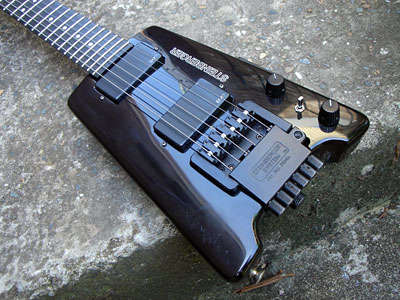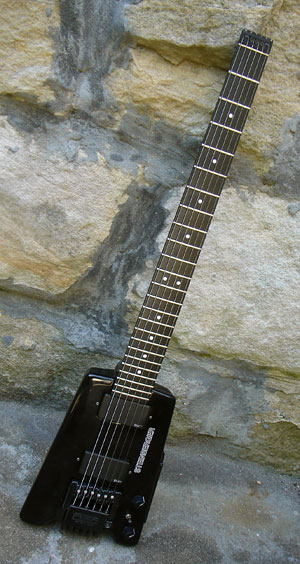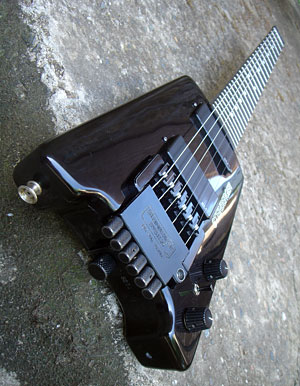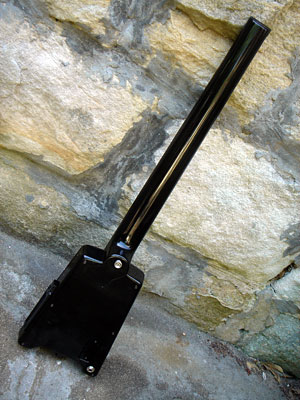1991 Steinberger GL 2S
This was bought from Dallas Texas in mid December 2009 and sold to a guy in Alaska in early 2011, from whom it was subsequently stolen. I believe it is one of the last Steinbergers made at the Newburgh factory, and it is one of the early all synthetic ones with the body and neck moulded as a single piece, as opposed to the modern ones that have wooden bodies and partly wooden bolt-on necks.
The "2" refers to the pickup configuration, and the "S" is the tremolo system. It has active EMG pickups with passive controls (one volume, one tone), and 3-way pickup selector.
These guitars and basses were an '80s classic and were used by members of Peter Gabriel's band, Duran Duran, David Bowie, Eddie Van Halen, and even Mark Knopfler. This was confirmed to me by a guitarist named Manning Bartlett who as a teenager worked as an Assistant Guitar Tech on the Australian leg of the Brothers In Arms tour in 1985. He told me that every night on that tour Mark Knopfler played 'Money For Nothing' using a black GL2TA.
Ned Steinberger was originally an industrial / furniture designer, who met a bass guitar builder and became interested in building musical instruments from there. Read the full story at the links below. The Steinberger Bass received numerous awards, including the "Design of the Decade" award from the Industrial Designer Society Of America.
By 1985 he was building guitars using the same principles, and also came up with some amazing tremolo systems for them. The design was copied by several companies in the '80s and beyond, for example my Riverhead bass, but as far as I know no others were made of the same material as a Steinberger.

They are moulded from a composite carbon fibre material that is incredibly hard, making them not only virtually indestructible, but also impervious to the usual guitar problems of heat and humidity. The necks will never warp and never need adjustment. In fact there is no way you can adjust them even if you want to because there is no truss rod.
Another unusual choice was that the fingerboards are made of phenolic resin, which is also used to make pool balls, bowling balls, and bearings. This means that the fingerboards are very durable and, like the rest of the construction, not affected by heat or humidity. Bakelite is one type of phenolic resin. The downside of this is that fret replacements are extremely difficult and expensive.
The construction process was also difficult and expensive, so they were very expensive to buy - $US1900 for the basic model without tremolo in 1986, US$2150 in 1991. Brand new Les Pauls were well under US$1000 in the 1980s (source: Les Paul forum). These Steinbergers are no longer made, although Gibson continues to build Steinbergers using wood and carbon fibre combinations.

They use a double ball end set of strings. They are not as easy or as cheap to buy as normal strings, but they are incredibly fast to change, so breaking a string during a performance will only stop the show for a couple of minutes.
They also do not go out of tune, because there is no slippage from normal tuners, no expansion and contraction of wood because of heat / humidity, and there is no nut for the strings to get stuck in. And, according to most reports, they're small enough to be allowed as cabin baggage on a plane.
These guitars are really a "love 'em or hate 'em" kind of thing. In mid 2010 I did a pro gig for a few weeks and one of the other musos said "I really admire a guitarist who's man enough to turn up with one of those".
More Info
- Steinberger World
This is a fan site with tons of very useful stuff - serial numbers, forums, where to get parts and repairs, original manuals, price lists, catalogues, etc. - Steinberger on wikipedia
- More about phenolic resin on wikipedia
- Steinberger.com
The official web site. - Steinbergers on The Guitar Show
Videos. - This article at premier guitar.com is actually about EMG pickups, but it talks about how intertwined the histories of EMG and Steinberger are. There's also a photo of Eddie Van Halen's Steinberger there.


